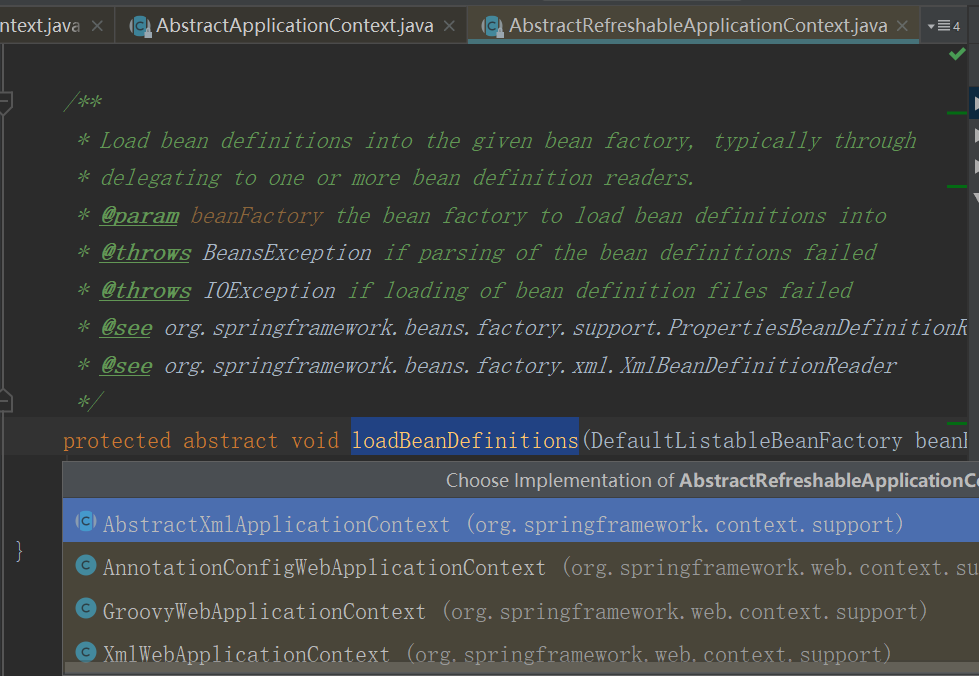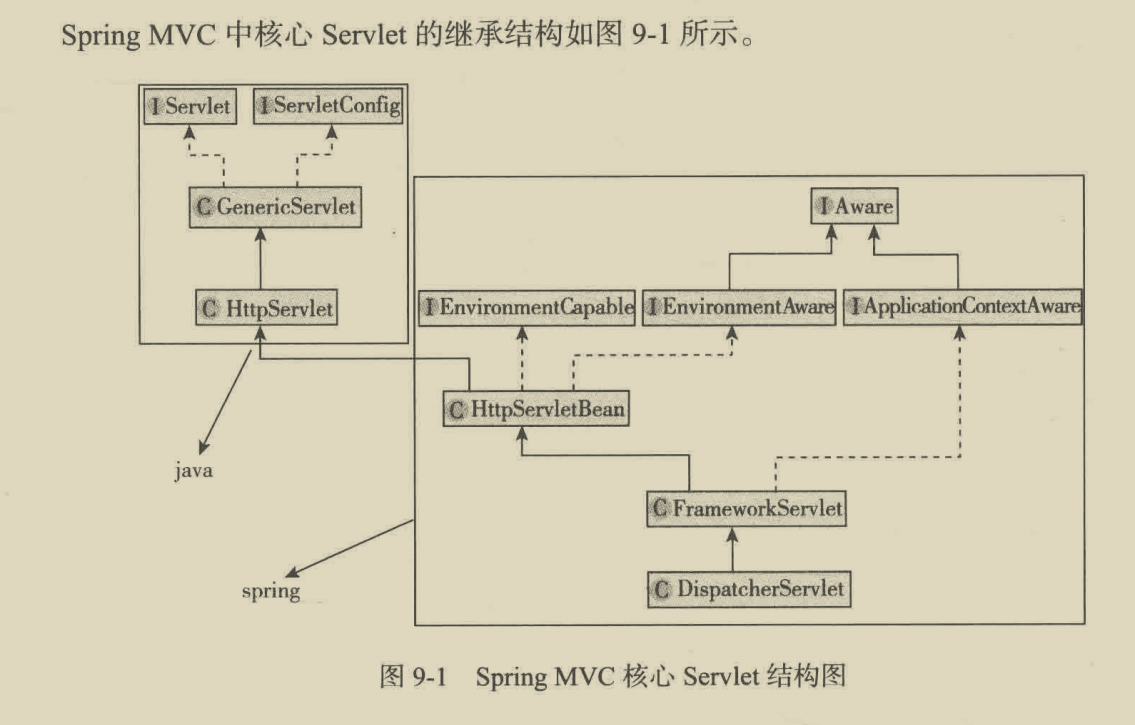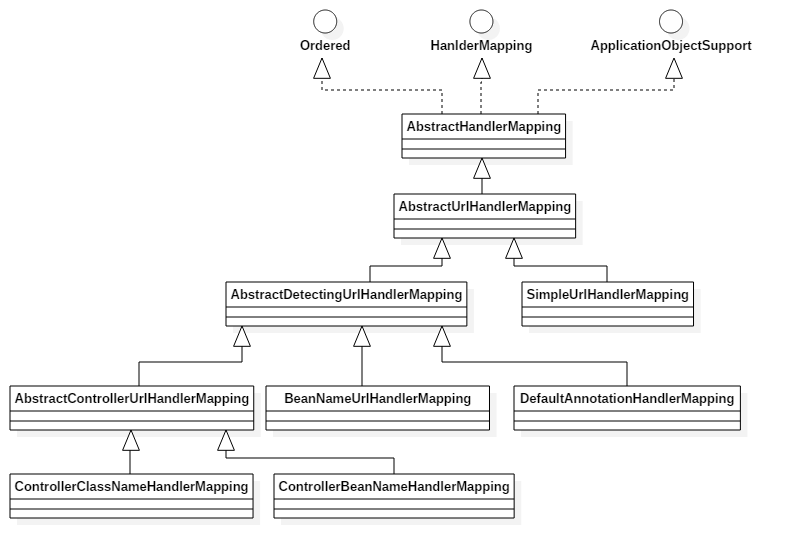2、Spring-RootApplicationContext-refresh
上一篇文中提到父容器root applicationContext最后是调用XmlWebApplicationContext去实现的,
但是什么时候开始解析标签(默认标签、自定义标签)、注册bean以及注解的bean加载等一些列的操作;
知识点普及:
在 Spring 项目中,加载 applicationContext.xml 的方法
1、FileSystemXmlApplicationContext
这个方法是从文件绝对路径加载配置文件,例如:
ApplicationContext ctx = new FileSystemXmlApplicationContext( "G:/Test/applicationcontext.xml ");
如果在参数中写的不是绝对路径,那么方法调用的时候也会默认用绝对路径来找,我测试的时候发现默认的绝对路径是eclipse所在的路径。
采用绝对路径的话,程序的灵活性就很差了,所以这个方法一般不推荐。
(如果要使用classpath路径,需要加入前缀classpath: )
2、ClassPathXmlApplicationContext
这个方法是从classpath下加载配置文件(适合于相对路径方式加载),
ApplicationContext ctx = new ClassPathXmlApplicationContext( "/applicationcontext.xml ");
下面我们就围绕这些问题展开摸索:
参数中classpath: 前缀是不需要的,默认就是指项目的classpath路径下面;
这也就是说用ClassPathXmlApplicationContext时默认的根目录是在WEB-INF/classes下面,而不是项目根目录。这个需要注意!
3、XmlWebApplicationContext
专为web工程定制的方法,推荐Web项目中使用。例如:
ServletContext servletContext = request.getSession().getServletContext(); ApplicationContext ctx = WebApplicationContextUtils.getWebApplicationContext(servletContext);
***************************************************************************************************************************************************************************************

public class XmlWebApplicationContext extends AbstractRefreshableWebApplicationContext {....}
public abstract class AbstractRefreshableWebApplicationContext extends
AbstractRefreshableConfigApplicationContext implements ConfigurableWebApplicationContext, ThemeSource {..} 看标红的东东这个就是我们的入口
public abstract class AbstractRefreshableConfigApplicationContext extends AbstractRefreshableApplicationContext
implements BeanNameAware, InitializingBean
/**
* Triggers {@link #refresh()} if not refreshed in the concrete context's
* constructor already.
*/
@Override
public void afterPropertiesSet() {
if (!isActive()) {
refresh();
}
}
public abstract class AbstractRefreshableApplicationContext extends AbstractApplicationContext {..}
@Override
public void refresh() throws BeansException, IllegalStateException {
synchronized (this.startupShutdownMonitor) {
// Prepare this context for refreshing.
prepareRefresh(); // Tell the subclass to refresh the internal bean factory.
ConfigurableListableBeanFactory beanFactory = obtainFreshBeanFactory(); // Prepare the bean factory for use in this context.
prepareBeanFactory(beanFactory); try {
// Allows post-processing of the bean factory in context subclasses.
postProcessBeanFactory(beanFactory); // Invoke factory processors registered as beans in the context.
invokeBeanFactoryPostProcessors(beanFactory); // Register bean processors that intercept bean creation.
registerBeanPostProcessors(beanFactory); // Initialize message source for this context.
initMessageSource(); // Initialize event multicaster for this context.
initApplicationEventMulticaster(); // Initialize other special beans in specific context subclasses.
onRefresh(); // Check for listener beans and register them.
registerListeners(); // Instantiate all remaining (non-lazy-init) singletons.
finishBeanFactoryInitialization(beanFactory); // Last step: publish corresponding event.
finishRefresh();
} catch (BeansException ex) {
if (logger.isWarnEnabled()) {
logger.warn("Exception encountered during context initialization - " +
"cancelling refresh attempt: " + ex);
} // Destroy already created singletons to avoid dangling resources.
destroyBeans(); // Reset 'active' flag.
cancelRefresh(ex); // Propagate exception to caller.
throw ex;
} finally {
// Reset common introspection caches in Spring's core, since we
// might not ever need metadata for singleton beans anymore...
resetCommonCaches();
}
}
}

1、boot AppliccationConetxt的Map在哪
2、Servlet ApplicationContext的Map在哪,如何进行参数绑定的?







/**
* Initialize the HandlerMappings used by this class.
* <p>If no HandlerMapping beans are defined in the BeanFactory for this namespace,
* we default to BeanNameUrlHandlerMapping.
*/
private void initHandlerMappings(ApplicationContext context) {
this.handlerMappings = null; if (this.detectAllHandlerMappings) {
// Find all HandlerMappings in the ApplicationContext, including ancestor contexts.
Map<String, HandlerMapping> matchingBeans =
BeanFactoryUtils.beansOfTypeIncludingAncestors(context, HandlerMapping.class, true, false);
if (!matchingBeans.isEmpty()) {
this.handlerMappings = new ArrayList<HandlerMapping>(matchingBeans.values());
// We keep HandlerMappings in sorted order.
AnnotationAwareOrderComparator.sort(this.handlerMappings);
}
}
else {
try {
HandlerMapping hm = context.getBean(HANDLER_MAPPING_BEAN_NAME, HandlerMapping.class);
this.handlerMappings = Collections.singletonList(hm);
}
catch (NoSuchBeanDefinitionException ex) {
// Ignore, we'll add a default HandlerMapping later.
}
} // Ensure we have at least one HandlerMapping, by registering
// a default HandlerMapping if no other mappings are found.
if (this.handlerMappings == null) {
this.handlerMappings = getDefaultStrategies(context, HandlerMapping.class);
if (logger.isDebugEnabled()) {
logger.debug("No HandlerMappings found in servlet '" + getServletName() + "': using default");
}
}
}
DispatcherServlet.java
/**
* Create a List of default strategy objects for the given strategy interface.
* <p>The default implementation uses the "DispatcherServlet.properties" file (in the same
* package as the DispatcherServlet class) to determine the class names. It instantiates
* the strategy objects through the context's BeanFactory.
* @param context the current WebApplicationContext
* @param strategyInterface the strategy interface
* @return the List of corresponding strategy objects
*/
@SuppressWarnings("unchecked")
protected <T> List<T> getDefaultStrategies(ApplicationContext context, Class<T> strategyInterface) {
String key = strategyInterface.getName();
String value = defaultStrategies.getProperty(key);
if (value != null) {
String[] classNames = StringUtils.commaDelimitedListToStringArray(value);
List<T> strategies = new ArrayList<T>(classNames.length);
for (String className : classNames) {
try {
// 加载这个class
Class<?> clazz = ClassUtils.forName(className, DispatcherServlet.class.getClassLoader());
// 实例化
Object strategy = createDefaultStrategy(context, clazz);
strategies.add((T) strategy);
}
catch (ClassNotFoundException ex) {
throw new BeanInitializationException(
"Could not find DispatcherServlet's default strategy class [" + className +
"] for interface [" + key + "]", ex);
}
catch (LinkageError err) {
throw new BeanInitializationException(
"Error loading DispatcherServlet's default strategy class [" + className +
"] for interface [" + key + "]: problem with class file or dependent class", err);
}
}
return strategies;
}
else {
return new LinkedList<T>();
}
}
# Default implementation classes for DispatcherServlet's strategy interfaces.
# Used as fallback when no matching beans are found in the DispatcherServlet context.
# Not meant to be customized by application developers. org.springframework.web.servlet.LocaleResolver=org.springframework.web.servlet.i18n.AcceptHeaderLocaleResolver org.springframework.web.servlet.ThemeResolver=org.springframework.web.servlet.theme.FixedThemeResolver org.springframework.web.servlet.HandlerMapping=org.springframework.web.servlet.handler.BeanNameUrlHandlerMapping,\
org.springframework.web.servlet.mvc.annotation.DefaultAnnotationHandlerMapping org.springframework.web.servlet.HandlerAdapter=org.springframework.web.servlet.mvc.HttpRequestHandlerAdapter,\
org.springframework.web.servlet.mvc.SimpleControllerHandlerAdapter,\
org.springframework.web.servlet.mvc.annotation.AnnotationMethodHandlerAdapter org.springframework.web.servlet.HandlerExceptionResolver=org.springframework.web.servlet.mvc.annotation.AnnotationMethodHandlerExceptionResolver,\
org.springframework.web.servlet.mvc.annotation.ResponseStatusExceptionResolver,\
org.springframework.web.servlet.mvc.support.DefaultHandlerExceptionResolver org.springframework.web.servlet.RequestToViewNameTranslator=org.springframework.web.servlet.view.DefaultRequestToViewNameTranslator org.springframework.web.servlet.ViewResolver=org.springframework.web.servlet.view.InternalResourceViewResolver org.springframework.web.servlet.FlashMapManager=org.springframework.web.servlet.support.SessionFlashMapManager

public abstract class ApplicationObjectSupport implements ApplicationContextAware {...}
@Override
public final void setApplicationContext(ApplicationContext context) throws BeansException {
if (context == null && !isContextRequired()) {
// Reset internal context state.
this.applicationContext = null;
this.messageSourceAccessor = null;
}
else if (this.applicationContext == null) {
// Initialize with passed-in context.
if (!requiredContextClass().isInstance(context)) {
throw new ApplicationContextException(
"Invalid application context: needs to be of type [" + requiredContextClass().getName() + "]");
}
this.applicationContext = context;
this.messageSourceAccessor = new MessageSourceAccessor(context);
initApplicationContext(context);
}
else {
// Ignore reinitialization if same context passed in.
if (this.applicationContext != context) {
throw new ApplicationContextException(
"Cannot reinitialize with different application context: current one is [" +
this.applicationContext + "], passed-in one is [" + context + "]");
}
}
}
public abstract class AbstractHandlerMapping extends WebApplicationObjectSupport implements HandlerMapping, Ordered {...}
/**
* Initializes the interceptors.
* @see #extendInterceptors(java.util.List)
* @see #initInterceptors()
*/
@Override
protected void initApplicationContext() throws BeansException {
extendInterceptors(this.interceptors);
detectMappedInterceptors(this.adaptedInterceptors);
initInterceptors();
}
public abstract class AbstractDetectingUrlHandlerMapping extends AbstractUrlHandlerMapping {....}
/**
* Calls the {@link #detectHandlers()} method in addition to the
* superclass's initialization.
*/
@Override
public void initApplicationContext() throws ApplicationContextException {
super.initApplicationContext();
detectHandlers();
}
/**
* Register all handlers found in the current ApplicationContext.
* <p>The actual URL determination for a handler is up to the concrete
* {@link #determineUrlsForHandler(String)} implementation. A bean for
* which no such URLs could be determined is simply not considered a handler.
* @throws org.springframework.beans.BeansException if the handler couldn't be registered
* @see #determineUrlsForHandler(String)
*/
protected void detectHandlers() throws BeansException {
if (logger.isDebugEnabled()) {
logger.debug("Looking for URL mappings in application context: " + getApplicationContext());
}
String[] beanNames = (this.detectHandlersInAncestorContexts ?
BeanFactoryUtils.beanNamesForTypeIncludingAncestors(getApplicationContext(), Object.class) :
getApplicationContext().getBeanNamesForType(Object.class)); // Take any bean name that we can determine URLs for.
for (String beanName : beanNames) {
String[] urls = determineUrlsForHandler(beanName);
if (!ObjectUtils.isEmpty(urls)) {
// URL paths found: Let's consider it a handler.
registerHandler(urls, beanName);
}
else {
if (logger.isDebugEnabled()) {
logger.debug("Rejected bean name '" + beanName + "': no URL paths identified");
}
}
}
}
demo
<bean class="org.springframework.web.servlet.handler.SimpleUrlHandlerMapping">
<property name="mappings">
<props>
<prop key="/userlist.htm">userController</prop>
</props>
</property>
</bean> <bean class="org.springframework.web.servlet.mvc.support.ControllerClassNameHandlerMapping"/> <bean class="org.springframework.web.servlet.handler.BeanNameUrlHandlerMapping"/> <bean class="org.springframework.web.servlet.mvc.annotation.DefaultAnnotationHandlerMapping"/> <bean id="userController" name="/users" class="cn.com.infcn.web.controller.UserController"></bean>
BeanNameUrlHandlerMapping.java
/**
* Checks name and aliases of the given bean for URLs, starting with "/".
*/
@Override
protected String[] determineUrlsForHandler(String beanName) {
List<String> urls = new ArrayList<String>();
if (beanName.startsWith("/")) {
urls.add(beanName);
}
String[] aliases = getApplicationContext().getAliases(beanName);
for (String alias : aliases) {
if (alias.startsWith("/")) {
urls.add(alias);
}
}
return StringUtils.toStringArray(urls);
}
DefaultAnnotationHandlerMapping.java
/**
* Checks for presence of the {@link org.springframework.web.bind.annotation.RequestMapping}
* annotation on the handler class and on any of its methods.
*/
@Override
protected String[] determineUrlsForHandler(String beanName) {
ApplicationContext context = getApplicationContext();
Class<?> handlerType = context.getType(beanName);
RequestMapping mapping = context.findAnnotationOnBean(beanName, RequestMapping.class);
if (mapping != null) {
// @RequestMapping found at type level
this.cachedMappings.put(handlerType, mapping);
Set<String> urls = new LinkedHashSet<String>();
String[] typeLevelPatterns = mapping.value();
if (typeLevelPatterns.length > 0) {
// @RequestMapping specifies paths at type level
String[] methodLevelPatterns = determineUrlsForHandlerMethods(handlerType, true);
for (String typeLevelPattern : typeLevelPatterns) {
if (!typeLevelPattern.startsWith("/")) {
typeLevelPattern = "/" + typeLevelPattern;
}
boolean hasEmptyMethodLevelMappings = false;
for (String methodLevelPattern : methodLevelPatterns) {
if (methodLevelPattern == null) {
hasEmptyMethodLevelMappings = true;
}
else {
String combinedPattern = getPathMatcher().combine(typeLevelPattern, methodLevelPattern);
addUrlsForPath(urls, combinedPattern);
}
}
if (hasEmptyMethodLevelMappings ||
org.springframework.web.servlet.mvc.Controller.class.isAssignableFrom(handlerType)) {
addUrlsForPath(urls, typeLevelPattern);
}
}
return StringUtils.toStringArray(urls);
}
else {
// actual paths specified by @RequestMapping at method level
return determineUrlsForHandlerMethods(handlerType, false);
}
}
else if (AnnotationUtils.findAnnotation(handlerType, Controller.class) != null) {
// @RequestMapping to be introspected at method level
return determineUrlsForHandlerMethods(handlerType, false);
}
else {
return null;
}
}
2、Spring-RootApplicationContext-refresh的更多相关文章
- 四、Spring Boot Web开发
四.Web开发 1.简介 使用SpringBoot: 1).创建SpringBoot应用,选中我们需要的模块: 2).SpringBoot已经默认将这些场景配置好了,只需要在配置文件中指定少量配置就可 ...
- JAVAEE——SSH项目实战06:统计信息管理、Spring注解开发和EasyUI
作者: kent鹏 转载请注明出处: http://www.cnblogs.com/xieyupeng/p/7190925.html 一.统计信息管理 二.Spring注解开发 1.service ...
- 四、spring成长之路——springIOC容器(下)
目录 5.spring注解开发(Spring扩展知识) 5.1定义配置类:@Configuration 声明一个类为IOC容器 @Bean定义一个Bean 5.2.按照条件进行注入 5.3.@Impo ...
- 五、spring之DI循环依赖
什么是循环依赖 循环依赖就是循环引用,就是两个或多个Bean相互之间的持有对方,比如CircleA引用CircleB,CircleB引用CircleC,CircleC引用CircleA,则它们最终反映 ...
- MyEclipse中删除对Struts、Hibernate、Spring .
已经导入一下框架,现在发现不想用了,要删除,发现麻烦,添加容易删除不易,下面这个帮你解决删除问题,本文为转载,我试过hibenate,挺好使,你们验证其他的框架 http://blog.csdn.ne ...
- 1、spring与springmvc父子容器
转载于http://www.tianshouzhi.com/api/tutorials/spring 1.0 spring与springmvc父子容器 1.spring和springmvc父子容器概念 ...
- spring自动扫描、DispatcherServlet初始化流程、spring控制器Controller 过程剖析
spring自动扫描1.自动扫描解析器ComponentScanBeanDefinitionParser,从doScan开始扫描解析指定包路径下的类注解信息并注册到工厂容器中. 2.进入后findCa ...
- 1、Spring In Action 4th笔记(1)
Spring In Action 4th笔记(1) 2016-12-28 1.Spring是一个框架,致力于减轻JEE的开发,它有4个特点: 1.1 基于POJO(Plain Ordinary Jav ...
- 转 Netflix OSS、Spring Cloud还是Kubernetes? 都要吧!
Netflix OSS.Spring Cloud还是Kubernetes? 都要吧! http://www.infoq.com/cn/articles/netflix-oss-spring-cloud ...
- EasyUI、Struts2、Hibernate、spring 框架整合
经历了四个月的学习,中间过程曲折离奇,好在坚持下来了,也到了最后框架的整合中间过程也只有自己能体会了. 接下来开始说一下整合中的问题和技巧: 1, jar包导入 c3p0(2个).jdbc(1个). ...
随机推荐
- Centos 7 配置 NFS
安装NFS包 yum install nfs-utils.x86_64 启动NFS服务需要首先启动rpcbind服务,这个rpcbind包已经在上面安装好了 先配置 /etc/exports 文件 v ...
- NodeJS_0001:关于install的方式
最近在写Node程序的时候,突然对 npm install 的-save和-save-dev 这两个参数的使用比较混乱.其实博主在这之前对这两个参数的理解也是模糊的,各种查资料和实践后对它们之间的异同 ...
- openlayers按坐标点播放
<!DOCTYPE html> <html lang="en"> <head> <meta charset="UTF-8&quo ...
- springboot的yml配置文件里有多个参数的调用方式
本篇教程适用于配置文件一级下有多个二级或三级时,如何在service层不用通过多个@Value就能获取配置文件的参数 例如yml配置是这样的: 如果service层要引用这些参数,用多个@Value( ...
- ubuntu set up 5 - VIM
Edit ~/.vimrc source vimrc: :so ~/.vimrc 1. ctrl - left/right 切换tabs https://vim.fandom.com/wiki/Usi ...
- Windows10通过命令行导出笔记本电池使用信息
powercfg /batteryreport /output "D:\Thinkpad x1c\battery_report_2020_2_25.html" 可以导出电池的电池类 ...
- Python通过paramiko批量远程主机执行命令
一.前言 在日常运维的过程中,经常需要登录主机去执行一些命令,有时候需要登录一批主机执行相同的命,手动登录执行的化效率太慢, 所以可以通过Python的paramiko模块批量执行,本篇文章基于pyt ...
- 简单理解Linux系统的挂载是什么鬼
转载自http://c.biancheng.net/view/2859.html Linux系统中“一切皆文件”,所有文件都放置在以根目录为树根的树形目录结构中.在 Linux 看来,任何硬件设备也都 ...
- VScode usage
Common settings editor.minimap.enabled //close the preview workbench.editor.show tabs // show f ...
- [HAOI2011] Problem b - 莫比乌斯反演
复习一下莫比乌斯反演 首先很显然用一下容斥把它转化成求 \(ans=\sum_{i=1}^a \sum_{j=1}^b [{gcd(i,j)=d}]\) 我们可以定义 f(d) 和 F(d) 如下: ...
